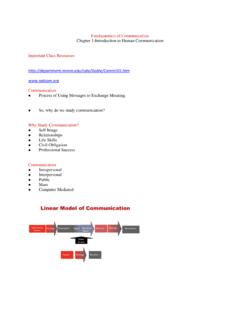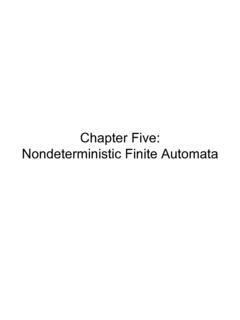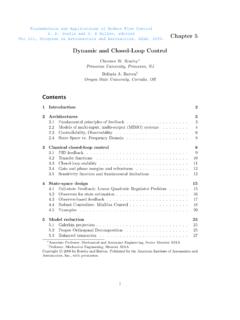Transcription of Chapter 3: Socialization - CSUN
1 1 | Page Chapter 3: Socialization Chapter Summary There has been and continues to be considerable debate over whether nature (heredity) or nurture (social environment) most determines human behavior. Studies of feral, isolated, and institutionalized children indicate that although heredity certainly plays a role in the human equation, it is society that makes people human. People learn what it means to be and, consequently, become members of the human community through language, social interaction, and other forms of human contact. People are not born with an intrinsic knowledge of themselves or others. Rather, as the theoretical insights of Charles Horton Cooley, George Herbert Mead, Jean Piaget, Lawrence Kohlberg, and Carol Gilligan demonstrate, they develop reasoning skills, morality, personality, and a sense of self through social observation, contact, and interaction. Cooley s conceptualization of the looking glass self shows how a person s sense of self is inextricably linked to that person s sense of others; an individual imagines how other people see him or her, interprets their reactions to his or her behaviors, and develops a self-concept based on those interpretations.
2 Mead s insights into taking the role of the other as well as how children learn through stages of imitation, play, and games illustrate the process by which people learn to become cooperative members of the human community and internalize the rules of the game of life. Furthermore, his formulation of the self as subject (the I ) and object (the me ) shows how Socialization is an active process and how the human mind, as well as the self, is a social product. Through observations of and experiments with young children, Piaget detailed four stages by which children typically develop the ability to reason: the sensorimotor stage (from birth to about age two), the preoperational stage (from about age two to age seven), the concrete operational stage (from about age seven to about age twelve), and the formal operational stage (after the age of about twelve). Building on Piaget s work, Kohlberg theorized that human beings develop morality through a series of stages: the amoral stage (from birth to about age seven), the preconventional stage (from about age seven to about age ten), the conventional stage (after the age of about ten), and the postconventional stage (a stage that, according to Kohlberg, most people do not reach).
3 Gilligan examined how gender affects the development of morality. Based on interviews with approximately 200 men and women, she concluded that women are more likely to evaluate morality in terms of personal relationships, while men tend to define right or wrong along the lines of abstract principles. Cooley s insights into the looking-glass self and Mead s insights into role taking and the mind appear to be universally applicable. Researchers are more divided, however, on Piaget s four stages of human development. Noting cultural and individual variations in the development of reasoning skills, some researchers argue that human beings develop reasoning skills more gradually and flexibly than Piaget s model suggests. Subsequent research and testing raised questions about Gilligan s work on gender and morality, when the results found no gender differences between males and females in moral reasoning. Because of these findings, Gilligan no longer fully supports her original position.
4 Sigmund Freud formulated personality in terms of the id (the inborn drives for self-gratification), the ego (the balancing force between the id and the demands of society that suppress it), and the superego (the conscience, representing culture within us). Many sociologists reject Freud s contention that inborn and unconscious motivations are the primary determinants of human behavior. However, many sociologists are attracted to 2 | Page Freud s notion that the super-ego represents the internalization of social norms. Feminists criticize Freud s theoretical assumption that maleness is normal and that females can be analyzed as inferior, castrated males suffering from penis envy. Socialization is not only critical internalizing social norms, to the development of the mind, but also to the development of emotions. Although there are some basic emotions that all people experience, all people do not express these emotions the same way or to the same extent.
5 Different Socialization experiences tied to regional, gender, and class differences, for example, may not only affect how people express their emotions, but also the particular emotions they may feel. Males and females learn what it means to be boys and girls and, later, men and women through gender Socialization the ways in which society sets children onto different courses in life because they are male or female. From the time of their birth, children are constantly presented with cultural messages that teach them how to act masculine or feminine based on their sex. Human beings learn how to think, behave, and act through agents of Socialization those people or groups that influence our self-concept, attitudes, behaviors, or other orientations toward life. Major agents of Socialization include the family, religion, daycare, school, peer groups, sports, and the workplace. When people move from one place, job, and/or life situation to another, they often have to undergo resocialization the process of learning new norms, values, attitudes, and behaviors.
6 Special settings that require intense resocialization, such as boot camps, prisons, and mental institutions, are called total institutions, a term coined by Erving Goffman to refer to a place where people are cut off from the rest of society and are almost totally controlled by the officials in charge. Socialization is not just limited to childhood; it is a lifelong process in which people, are taught, learn, and/or adjust to the needs, expectations, and responsibilities that typically accompany different stages in life. Although Socialization has a tremendous influence, within the limitations of the framework laid down by our social location, on how people think and act, human beings are not prisoners of Socialization . They have a considerable degree of freedom of choice, for example, to choose which agents of Socialization to follow (except for family), and which cultural practices or messages to accept or reject from those agents of Socialization .
7 We can even change our sense of self. Humans are not robots, and are therefore, unpredictable which makes the job of the sociologist more difficult. Humans are not sponges that passively absorb environmental influences. They are in fact active in their own environments and receive different treatment from others around them. Even identical twins do not receive identical reactions from others. Chapter outline I. What Is Human Nature? A. For centuries, people have tried to find an answer to the question of what is human about human nature. Studies of identical twins who have been reared apart help answer the question. B. Feral (wild) children have occasionally found children living in the woods who may have been raised by wild animals. These stories lead one to wonder what humans would be like if left untouched by society. C. Isolated children show what humans might be like if secluded from society at an early age. Isabelle is a case in point. Although initially believed to be retarded, a surprising thing happened when she was given intensive language training.
8 She began to acquire language and in only two years she had reached the normal intellectual level for her age. Without language there can be no culture or shared way of living. D. Institutionalized children show that traits such as intelligence, cooperative behavior, and friendliness are the result of early close relations with other humans. Research with children reared in orphanages and cases like Genie, the 13 -year-old who had been kept locked in a small room for years, demonstrate the importance of early interaction for human development. 3 | Page E. The Harlow s studies of monkeys reared in isolation have reached similar results. They concluded that if isolated for that longer than six months, the more difficult adjustment becomes. F. Babies do not naturally develop into human adults; although their bodies grow, human interaction is required for them to acquire the traits we consider normal for human beings. The process by which we learn the ways of our society, through interaction with others, is Socialization .
9 II. Socialization into Self, Mind, and Emotions A. Charles H. Cooley (1864-1929) concluded that human development is socially created that our sense of self develops from interaction with others. He coined the term looking-glass self to describe this process. 1. According to Cooley, this process contains three steps: (1) we imagine how we look to others; (2) we interpret others reactions (how they evaluate us); and (3) we develop a self-concept. 2. A favorable reflection in the social mirror leads to a positive self-concept, while a negative reflection leads to a negative self-concept. 3. Even if we misjudge others reactions, the misjudgments become part of our self-concept. 4. This development process is an ongoing, lifelong process. B. George H. Mead (1863-1931) agreed with Cooley but added that play is critical to the development of a self. In play, we learn to take the role of others to understand and anticipate how others feel and think. 1.
10 Mead concluded that children are first able to take only the role of significant others (parents or siblings, for example); as the self develops, children internalize the expectations of other people, and eventually the entire group. Mead referred to the norms, values, attitudes and expectations of people in general as the generalized other. 2. According to Mead, the development of the self goes through stages: (1) imitation (children initially can only mimic the gestures and words of others); (2) play (beginning at age three, children play the roles of specific people, such as a firefighter or the Lone Ranger); and (3) games (in the first years of school, children become involved in organized team games and must learn the role of each member of the team). 3. He distinguished the I from the me in development of the self: the I component is the subjective, active, spontaneous, creative part of the social self (for instance, I shoved him ), while the me component is the objective part attitudes internalized from interactions with others (for instance, He shoved me ).















